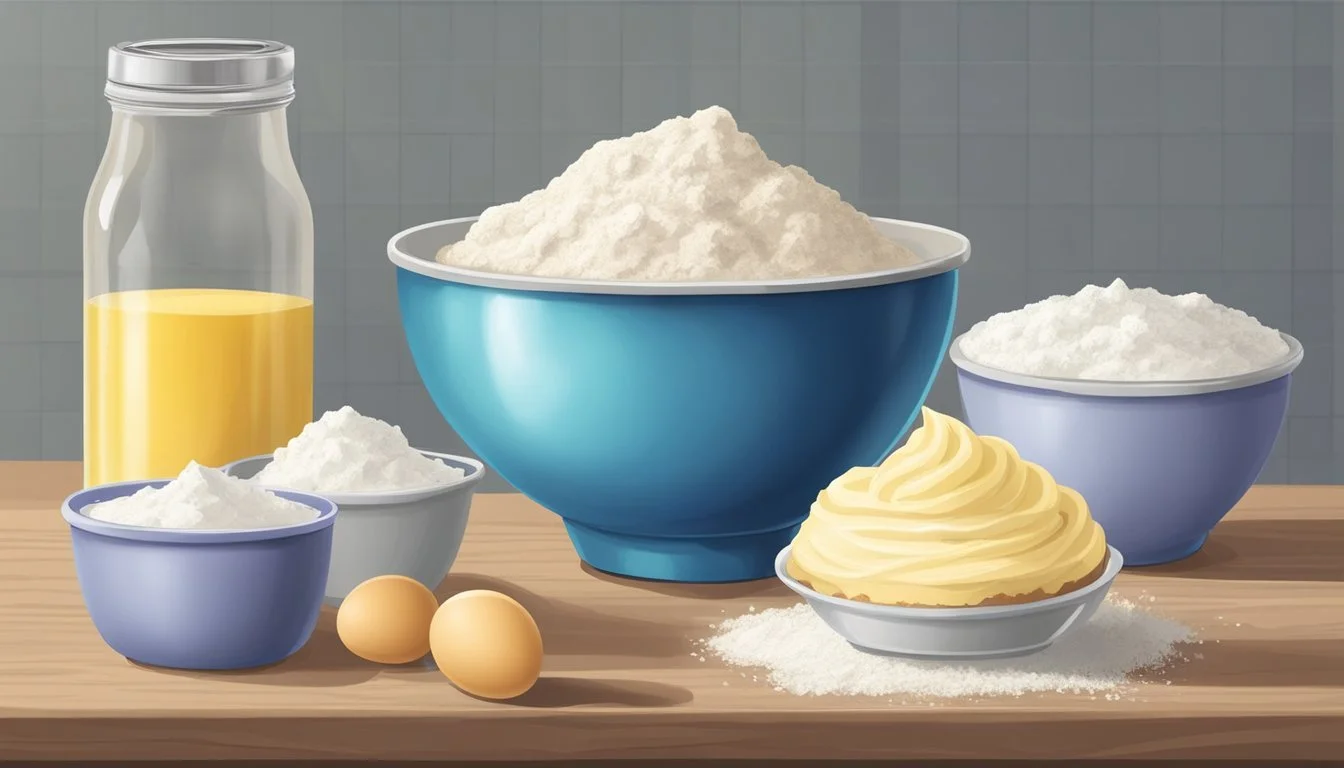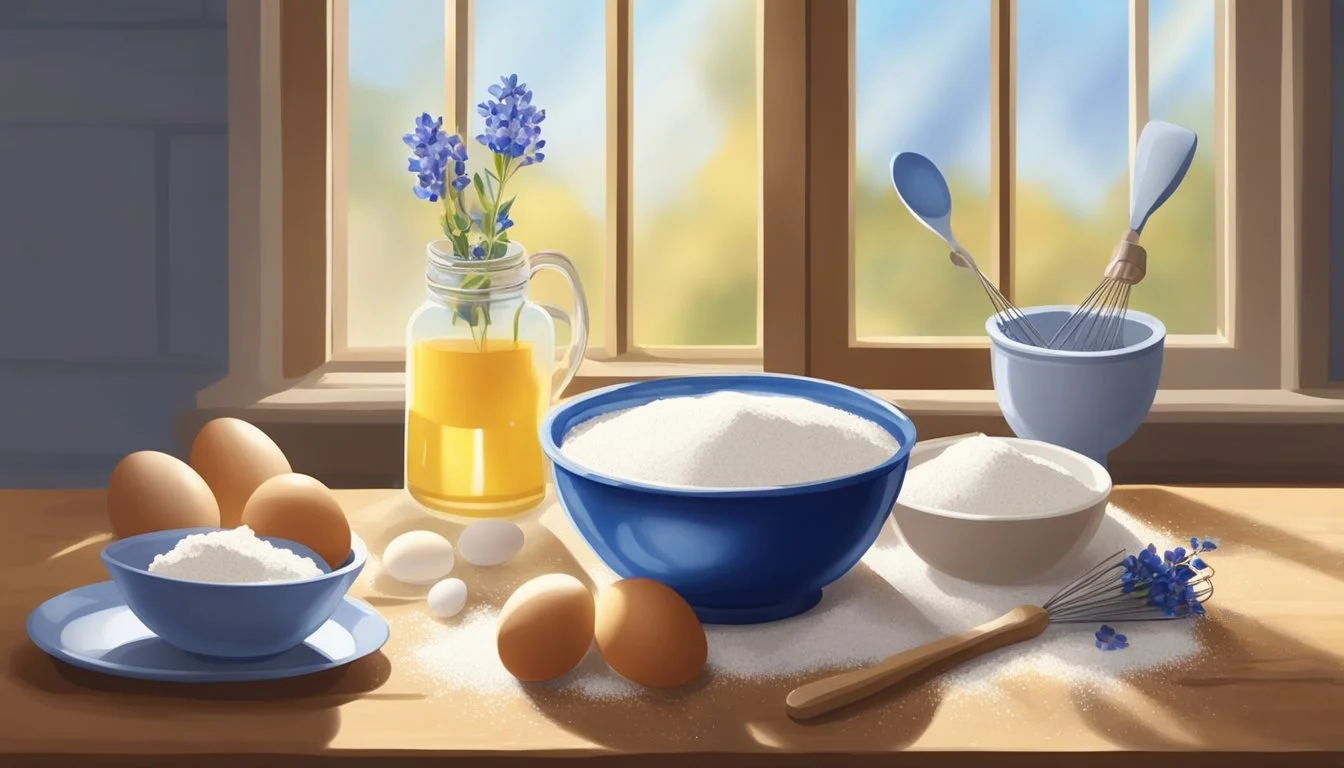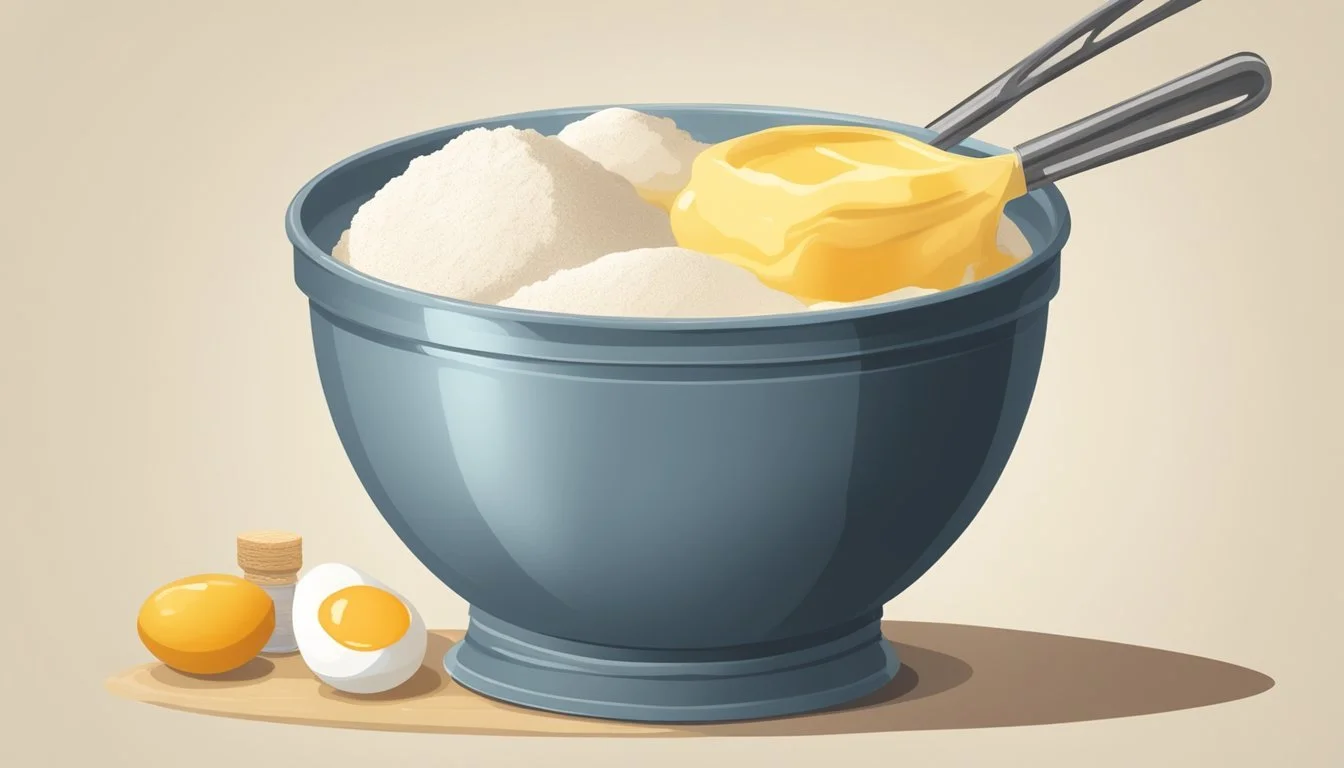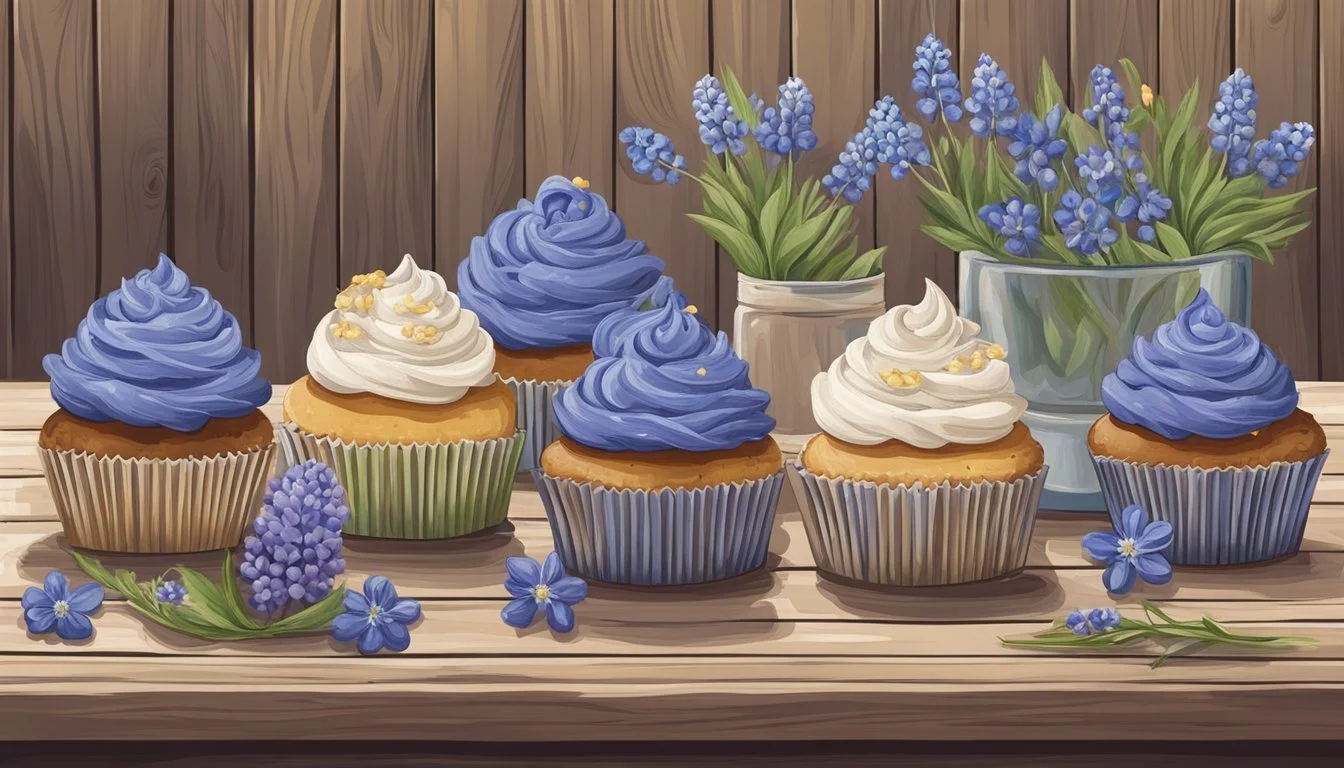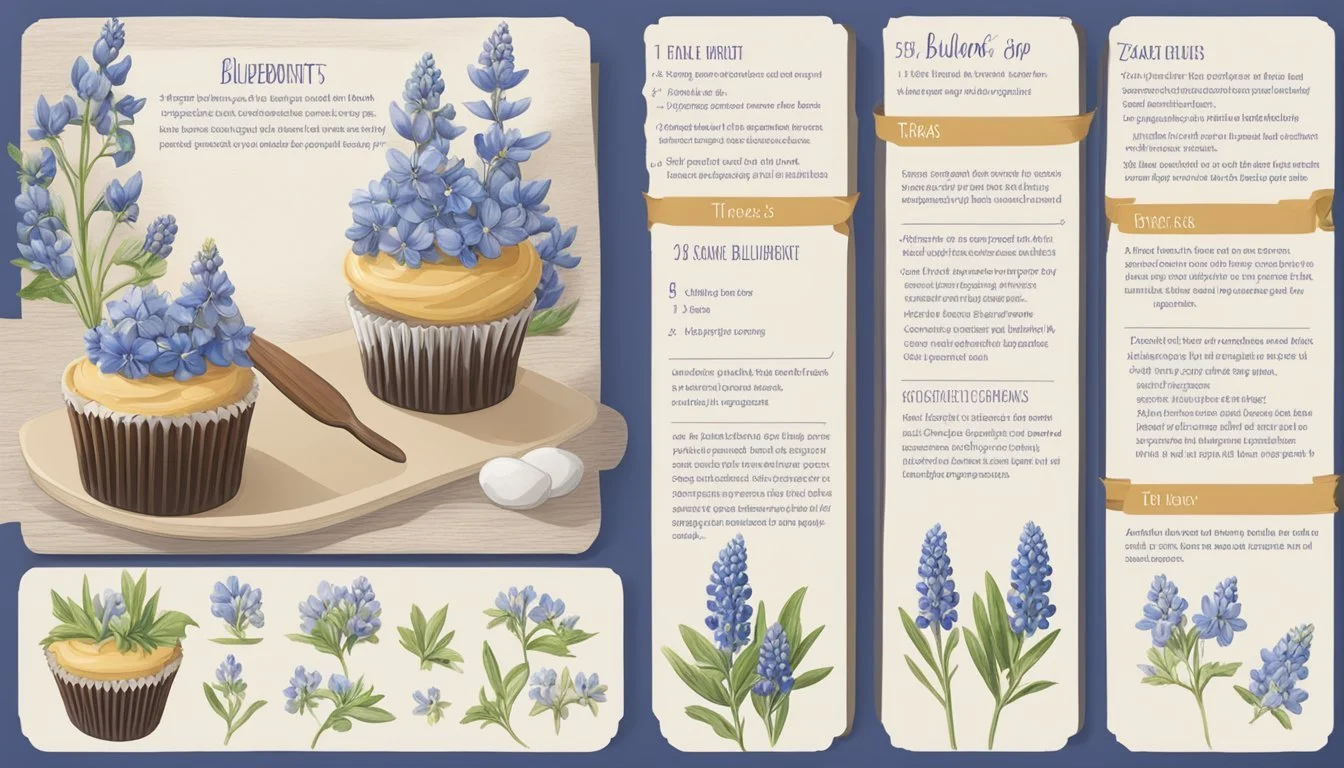How to Bake Texas Bluebonnet Cupcakes
A Step-by-Step Guide
Baking cupcakes might seem like a simple affair, but when it comes to Texas Bluebonnet Cupcakes, the task takes on a whole new level of detail. These cupcakes are not only a nod to the state's iconic flower, the bluebonnet, but also a celebration of Texan baking culture. To achieve the perfect balance of flavor and decoration, bakers must pay close attention to the ingredients and the baking process, as well as the artistic finishing touches that mimic the bluebonnet's unique beauty.
The foundation of any cupcake is the batter, and Texas Bluebonnet Cupcakes are no exception. They require a delicate mix of flour, leavening agents, and wet ingredients to create a moist and tender base. Baking them to perfection involves setting the oven to the right temperature, in this case typically around 350°F, and timing the baking process carefully to ensure a golden top and a springy touch.
Once baked and cooled, the true artistry of the Texas Bluebonnet Cupcakes comes to play in the decoration. With precision, bakers use various shades of blue and white icing to bring the likeness of the Texas bluebonnet to life atop each cupcake. By skillfully applying the icing, they turn an ordinary baked good into a small tribute to Texas, recognizable at first glance to anyone familiar with the state's floral emblem.
Gathering the Ingredients
To bake Texas Bluebonnet Cupcakes, one must carefully select high-quality ingredients and appropriate baking tools that contribute to the authentic flavors and textures of this delectable dessert.
Selecting Flour
The foundation for these cupcakes is all-purpose flour, providing the necessary structure. For an accurate composition, they must measure the flour by spooning it into the measuring cup and leveling it off, rather than scooping directly from the bag, which can lead to excess.
Choosing Sugars
A combination of granulated sugar for sweetness and powdered sugar for the frosting creates a balance of flavor and texture. The granulated sugar will ensure a tender crumb, while the powdered sugar will contribute to a smooth frosting finish.
Incorporating Fats
Unsalted butter is preferred for its ability to let the natural flavors shine through. The butter should be at room temperature to seamlessly blend into the batter and frosting.
Adding Eggs
Large eggs are essential for binding the ingredients together and providing moisture. They should also be at room temperature to ensure an even incorporation into the batter.
Liquids and Leavening Agents
The liquids, milk or buttermilk, add moisture and a slight tanginess, while baking soda acts as the leavening agent, giving rise to the cupcakes. Ensure that the milk or buttermilk is fresh for the best results.
Flavorings and Extras
Adding vanilla extract enhances the flavor profile of the cupcakes. For a unique Texan touch, a hint of ground cinnamon or a splash of brewed coffee can elevate the cupcakes' taste. Chopped pecans or similar nuts can be included for an added crunch.
Decorative Elements
To garnish, use either cream cheese frosting or fudge frosting and finish with decorative edible bluebonnets. For creating a themed look, opt for blue cupcake liners representing the vibrant color of Texas bluebonnets.
Baking Tools and Equipment
The necessary tools include an oven, cupcake pans with paper liners, whisk, spatula, at least one mixing bowl, and an electric mixer. Each tool plays a pivotal role in the mixing, baking, and assembly of the cupcakes.
Preparing the Batter
For successful Texas Bluebonnet Cupcakes, precision in preparing the batter is key. It involves carefully mixing dry and wet ingredients separately before combining them to create a smooth and consistent mixture.
Mixing Dry Ingredients
Ingredients:
2 cups all-purpose flour
1 ½ teaspoons baking powder
½ teaspoon salt
(Optional) 2 tablespoons cocoa powder for a chocolate twist
Method:
Begin by sifting the 2 cups of all-purpose flour with the 1 ½ teaspoons of baking powder and ½ teaspoon of salt into a large mixing bowl. This ensures a lump-free consistency.
If opting for a chocolate version, whisk 2 tablespoons of cocoa powder into the mixture.
Combining Wet Ingredients
Ingredients:
1 stick (1/2 cup) unsalted butter, softened
1 1/4 cups granulated sugar
2 large eggs
1 cup milk or a combination of sour cream and buttermilk for extra moisture
2 teaspoons pure vanilla extract
Method:
In a separate bowl, cream the butter and granulated sugar until light and fluffy, which usually takes about 3-4 minutes with an electric mixer.
Add the 2 large eggs one at a time, beating well after each addition.
Stir in the milk, sour cream or buttermilk, and 2 teaspoons of vanilla extract until the mixture is well combined.
Merging Wet and Dry Mixes
Gradually pour the wet ingredients into the dry ingredients, stirring gently until just combined. Overmixing should be avoided as it can lead to dense cupcakes.
Ensure both mixes come together to create a uniform batter without overworking it to maintain the cupcakes' tenderness.
Next, the batter is ready to be portioned into cupcake liners and baked until they pass the toothpick test.
Baking the Cupcakes
This section will guide the reader through the key stages of baking Texas Bluebonnet Cupcakes, from preparing the liners to monitoring the baking process for perfect results.
Filling the Cupcake Liners
To begin, one must fill cupcake liners with the batter properly, ensuring consistency in size and shape. Use Texas-sized cupcake liners for larger cupcakes, and fill each liner about two-thirds full with batter to allow for expansion while baking and prevent overflow. This uniformity is crucial for even baking.
Setting the Oven
Before starting, preheat the oven to 350°F (177°C), which is the optimal temperature for baking these cupcakes. Position the racks in the center of the oven to ensure even heat distribution. Using an oven thermometer can help verify the accuracy of the oven's temperature settings.
Monitoring the Baking Process
Baking requires attention and accurate timing. Bake the cupcakes for about 20-25 minutes. To check for doneness, insert a toothpick into the center of a cupcake; it should come out clean when the cupcakes are ready. Once baked, remove the cupcakes from the oven and let them cool in the pan for 10 minutes before transferring to a wire rack to finish cooling completely. This ensures the cupcakes set properly and prevents them from becoming soggy.
Making Texas Sheet Cake Frosting
The frosting for a Texas Sheet Cake is notorious for its rich chocolate flavor and smooth, pourable texture. It is typically crafted on the stovetop and poured over the cake while still warm, allowing it to seep into the cake and create a decadent, glossy layer.
Preparing the Frosting Base
To begin, one must gather all necessary ingredients. The base of the frosting is a combination of butter, milk, and unsweetened cocoa powder. In a saucepan, the chef combines these items:
Butter: 1/2 cup (1 stick)
Milk: 6 tablespoons
Unsweetened Cocoa Powder: 1/4 cup
These ingredients are then heated over medium heat until they are fully melted and well-integrated, stirring constantly to prevent burning. Once the mixture reaches a gentle boil, it should be removed from heat to incorporate the remaining ingredients.
Enhancing Flavor and Texture
After removing the saucepan from the heat, the chef adds powdered sugar, vanilla extract, and chopped pecans to enhance flavor and texture:
Powdered Sugar: 3 1/2 to 4 cups, sifted
Vanilla Extract: 1 teaspoon
Chopped Pecans: 1/2 cup (optional for nut-free preferences)
The powdered sugar is gradually whisked into the chocolate mixture to prevent clumping and to create a smooth consistency. The vanilla extract is added for its aromatic essence, while the pecans, if one opts to include them, provide a satisfying crunch. It's vital to stir until the frosting is smooth and has a pourable consistency, perfect for topping your Texas Bluebonnet Cupcakes.
Decorating and Presenting Cupcakes
Decorating Texas Bluebonnet cupcakes involves two main tasks: applying frosting and toppings to encapsulate the flavor of the dessert, and presenting them in a way that underscores their deliciousness. Pecans, cream cheese frosting, and chocolate icing are commonly used to both enhance the taste and the visual appeal.
Applying Frosting and Toppings
When it comes to applying frosting, the Texas Bluebonnet cupcake is often dressed in either cream cheese frosting to offer a tangy counterpoint to the sweetness of the cake or with rich fudge frosting for chocolate lovers. The frosting should be brought to room temperature for a smoother application.
Cream cheese frosting:
Ensure the cream cheese and butter are softened for easy mixing.
Beat the cream cheese with butter until light and fluffy.
Gradually add powdered sugar to the mix for desired sweetness.
Fudge frosting:
Melt butter with chocolate, stirring until they are harmoniously combined.
Sift in powdered sugar and cocoa powder, whisking into a glossy, spreadable consistency.
For toppings, a sprinkle of chopped pecans adds a delightful crunch. They should be toasted to enhance their nutty flavor and laid on top of the frosting while it's still soft to ensure they adhere properly.
Serving Suggestions
Presentation is key in making any dessert stand out. Cupcakes should be refrigerated if they are not to be served immediately, especially if they are topped with cream cheese frosting to maintain its structure. For the best taste and texture, bring them back to room temperature before serving.
Cupcakes can be arranged on a serving platter in the shape of a Texas Bluebonnet or presented individually in decorative cupcake holders to resemble a blooming flower. For added birthday cake festivity, inserting a small candle or a themed topper appropriate for the occasion can transform the cupcake presentation into a celebratory centerpiece.
Storing and Keeping Cupcakes Fresh
Proper storage is crucial for keeping cupcakes moist and fresh. Whether one opts for refrigeration or room temperature storage, understanding the nuances of each method ensures optimal preservation of Texas Bluebonnet cupcakes.
Refrigeration and Room Temperature Storage
Refrigeration is recommended when cupcakes contain perishable fillings or frostings, such as cream cheese or whipped cream. To refrigerate:
Place cupcakes in an airtight container.
Ensure the container is deep enough to not crush the frosting.
They can be stored for 3-5 days in the refrigerator.
It's vital to note that refrigerating cupcakes can sometimes dry them out, so they should be consumed relatively quickly.
Room Temperature Storage is suitable for cupcakes without perishable ingredients. To store at room temperature:
Allow cupcakes to cool completely after baking.
Store them in an airtight container to keep them moist.
Keep the container out of direct sunlight and away from heat sources.
Cupcakes typically stay fresh for up to two days when stored this way.
For both methods, one should ensure the cupcakes are not warm to prevent condensation which can reduce freshness.
Tips and Tricks for Perfect Cupcakes
When baking Texas Bluebonnet Cupcakes, the goal is to create a treat that is as delightful to look at as it is to taste. Precision in the consistency of the batter, uniform baking, and adding personal touches can turn a good cupcake into a great one.
Achieving the Right Consistency
The batter's consistency is crucial for moist cupcakes with the ideal crumb. To start:
Eggs: Ensuring that eggs are at room temperature helps them mix better with the batter. Quickly warm cold eggs by placing them in a bowl of hot water for about five minutes.
Milk: If the recipe calls for it, milk should also be at room temperature. This can be achieved by heating it in the microwave for about 30 seconds and testing it to avoid overheating.
Incorporating ingredients like bourbon can add a unique flavor to chocolate cupcakes, but they should be added gradually to maintain the proper consistency and not overwhelm the batter.
Ensuring Even Baking
Even baking is key for cupcakes that are perfectly done from center to edge.
Oven Placement: Always preheat the oven to the correct temperature before baking. Center the cupcake or muffin tin in the middle of the oven to ensure even heat distribution.
Baking in Batches: If the oven space is limited and all the pans cannot fit on one rack, bake the cupcakes in separate batches rather than using multiple racks.
Rotation: About halfway through the baking process, carefully rotate the cupcake pan 180 degrees to counter uneven oven heat, promoting uniform rise and bake.
Customization Ideas
Customization elevates a standard recipe into something memorable. Consider the following:
Frosting: Tailor flavors to your preference or event theme, exploring options such as bourbon-infused chocolate frosting for an adult twist.
Toppings: Chocolate shavings or themed edible decorations can enhance both flavor and appearance.
For a fudgy texture, under-bake the cupcakes ever so slightly, retaining a bit more moisture.
Remember that a good cupcake is one that bakes evenly, achieves a balance in moisture and flavor, and offers a visual appeal that matches its taste.
Understanding the Origins of Texas Bluebonnet Cupcakes
Texas Bluebonnet Cupcakes are a delightful fusion of the classic Texas Sheet Cake and the portability of cupcakes, topped with the charm of the state's iconic flower for a distinct Texan treat.
History of the Texas Sheet Cake
The Texas Sheet Cake is a staple in Texan cuisine, known for its moist, dense texture and chocolate richness. It typically contains buttermilk for added tenderness, cocoa for its signature chocolate flavor, and often includes a pecan frosting. The cake's history is as rich as its flavor, with debates regarding its origin. However, it's widely agreed that it became popular in Texas during the mid-20th century, possibly due to the availability of the recipe on cocoa powder packaging.
Adaptation to Cupcake Form
The adaptation of Texas Sheet Cake to cupcakes combines traditional sheet cake recipes with the convenience of individual servings. Texas Sheet Cake Cupcakes have made the experience of eating this traditional dessert more personal and customizable. The rich, chocolatey cupcakes are often topped with the classic boiled frosting, providing an authentic Texas Sheet Cake taste in a more manageable cupcake form.
It's essential to maintain the sheet cake's principal ingredients and cooking methods to preserve authenticity, adjusting portions to suit the smaller size of cupcakes. Most recipes maintain the integral use of buttermilk, cocoa, and, in some variations, pecan nuts to align with the essence of the original Texas Sheet Cake.
Nutritional Information
The nutritional content of Texas Bluebonnet cupcakes is an essential aspect for those monitoring their diet or health. This information enables individuals to understand what they are consuming and make informed decisions regarding their dessert and overall nutritional intake.
Calculating Caloric Content
Texas Bluebonnet cupcakes, like any dessert, contain a number of calories that contribute to one's daily caloric intake. To calculate the caloric content accurately, each ingredient used in the recipe needs to be accounted for. Typically, the major calorie-contributing ingredients in cupcakes include flour, sugar, eggs, butter, and any added frostings or fillings.
For a standard-sized Texas Bluebonnet cupcake, one may start by breaking down the ingredients as follows:
Flour: A typical cupcake might use about 1/4 cup of flour, amounting to approximately 114 calories.
Sugar: If a recipe calls for 1/3 cup of sugar, this is equivalent to about 255 calories.
Butter: For 1/4 cup of butter, used in both the cupcake and icing, it constitutes around 400 calories.
Eggs: On average, one large egg adds about 72 calories to the mix.
Frosting: Depending on the ingredients, a standard serving of frosting can add an additional 70 to 130 calories.
In sum, a single unfrosted Texas Bluebonnet cupcake may contain about 440-500 calories, and frosting can increase this total to about 510-630 calories. This estimate does not account for variations in recipe or serving size and may not include other potential ingredients such as cocoa, buttermilk, or additional flavorings and decorations which could also affect the caloric content.
One should also consider the presence of other nutritional elements such as fats, carbohydrates, and proteins, along with micronutrients like vitamins and minerals that may impact health. A detailed breakdown would involve analyzing each ingredient for its respective nutritional value and adding them up for the total count. When consuming Texas Bluebonnet cupcakes, they should practice moderation, especially if they are following a specific nutrition or diet plan.
FAQs About Baking Cupcakes
In this section, they address frequently asked questions about the cupcake baking process, focusing on techniques and ingredients to ensure success.
Common Questions Answered
What is the difference between baking powder and baking soda?
Baking powder contains baking soda along with an acidifying agent and a drying agent, whereas baking soda needs an acidic ingredient to react with in the recipe.How can one tell when cupcakes are fully baked?
A toothpick inserted into the center should come out clean. The tops will also spring back when lightly touched.Can baking soda or baking powder lose potency over time?
Yes, they can. To test for freshness, one can stir half a teaspoon of baking powder into a cup of hot water. If it bubbles, it's fresh. For baking soda, add a few drops of vinegar to a half teaspoon. If it fizzes, it's still good.What causes cupcakes to have a peaked top rather than being flat?
Overmixing the batter or setting the oven temperature too high can cause this to happen.How important is it to follow the exact order of adding ingredients when baking cupcakes?
It's quite important because the order in which ingredients are combined can affect the texture and rise of the cupcakes.Why is it necessary to use liners in cupcake baking?
Liners prevent the cupcakes from sticking to the pan and make them easier to remove and handle.How full should one fill the cupcake liners?
They should usually be filled no more than two-thirds full to allow for proper rising without overflowing.Is it better to use room temperature ingredients when making cupcakes?
Yes, especially for butter and eggs, as room temperature ingredients cream easier and combine more readily, resulting in a smoother batter.
Alternate Variations and Flavors
When baking Texas Bluebonnet Cupcakes, enthusiasts can broaden their culinary horizons by experimenting with various cake mixes and innovative frosting combinations. These modifications can transform the flavor profile and aesthetic of the traditional cupcake.
Exploring Different Cake Mixes
Chocolate: Intensely rich and beloved, chocolate cake mix can serve as a sumptuous base. One can enhance its depth by adding espresso powder or chocolate chunks.
Vanilla: A classic choice, vanilla cake mix provides a canvas for adding vibrant flavors like lemon zest or almond extract to create a nuanced taste.
Spice Cake: Embracing autumnal warmth, a spice cake mix can incorporate elements such as cinnamon and nutmeg, pairing splendidly with cream cheese frosting.
Innovative Frosting Combinations
Chocolate Icing: Velvety chocolate icing pairs excellently with various flavors. One can infuse it with orange liqueur for a zesty kick or peppermint extract for a cool twist.
Cream Cheese Frosting: For a luxurious texture and tangy taste, cream cheese frosting is versatile. It can be flavored with vanilla bean seeds or even savory spices like cardamom for an exotic touch.
Swiss Buttercream: Known for its smoothness, Swiss buttercream can be a blank slate for flavors ranging from salted caramel to berry purées, offering an upscale twist on the classic frosting.
Conclusion
In the process of creating Texas Bluebonnet Cupcakes, bakers combine traditional cupcake making techniques with the distinctive charm of the Texas state flower. The process requires attention to detail, from the precise measurement of ingredients to the attentive baking times. Achieving a light and fluffy texture is paramount, as is ensuring the flavors complement each other harmoniously.
A successful batch of Texas Bluebonnet Cupcakes should exhibit the following characteristics:
A moist crumb, indicative of proper ingredient balance and baking time.
A delicate, subtle flavoring that pays homage to the bluebonnet—often achieved through the use of vanilla or a hint of lemon for a fresh, floral note.
An aesthetically pleasing appearance, often accomplished with blue-tinted frosting and edible decorations resembling the bluebonnet flower.
The key steps in this baking endeavor include:
Precise oven calibration to 350°F to ensure uniform baking.
Thorough preparation of the cupcake batter with quality ingredients.
Accurate timing, typically between 18-20 minutes in the oven, followed by cooling on a wire rack.
In summary, the artistry of Texas Bluebonnet Cupcakes lies in their ability to capture the essence of Texas's state flower, not just in appearance but in taste—a task that requires both skill and patience. They are a delight both to the eyes and the palate, perfect for any event that calls for a touch of Lone Star State pride.

